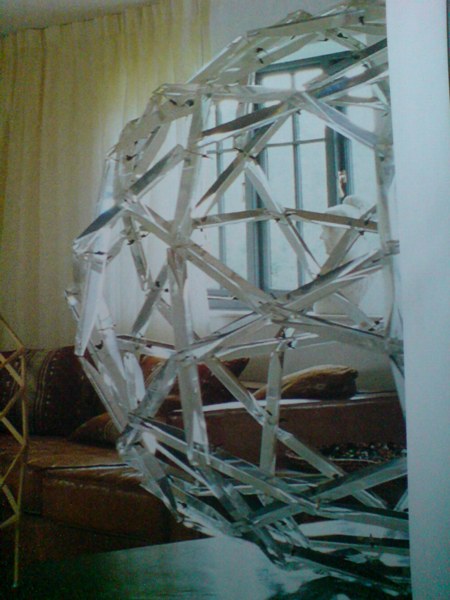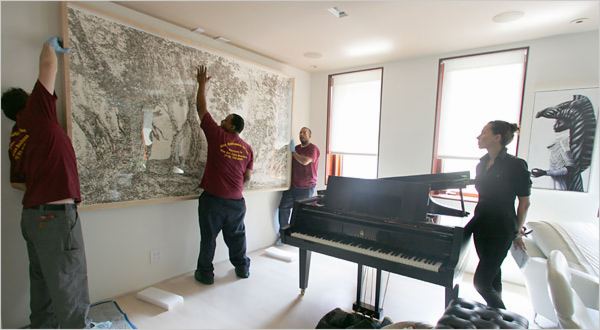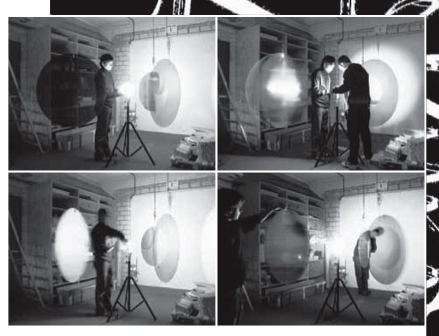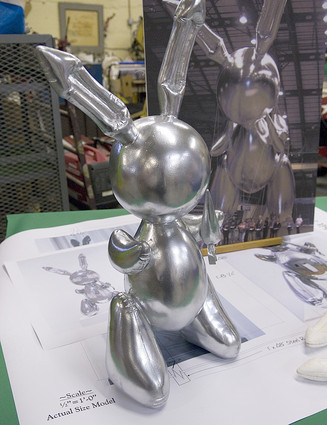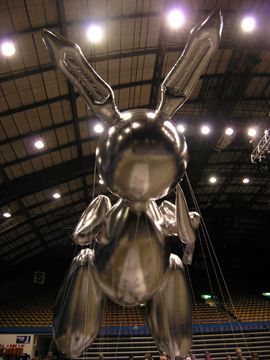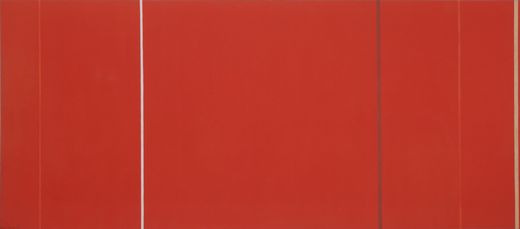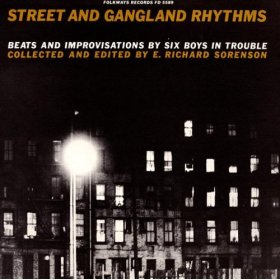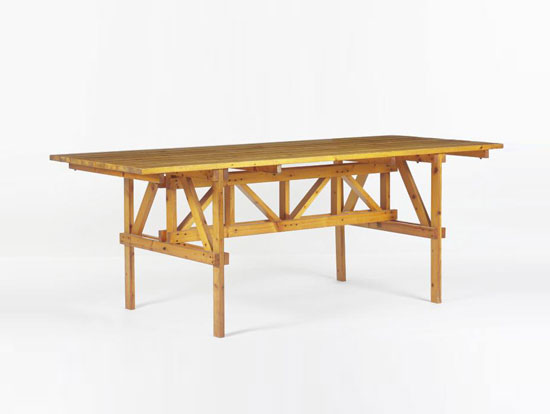I guess when you're a hammer, everything looks like MoMA. It's "Subverting The Dominant Installation" Week at Modern Art Notes, where Tyler is taking inordinate pleasure in shadow boxing with an opponent who retired long ago: Alfred Barr's rickety, linear [sic] march of Modern Art history as experienced in the gallery walk at MoMA. As Tyler condemns it, Barr/Rubin/MoMA put Postwar New York at the center of Art, and annointed Jackson Pollock to lead everyone else to abstraction's Promised Land. [But wait, maybe I can solve this problem before I even get started complaining. What if Clyfford Still is Moses, then Pollock could be Joshua!]
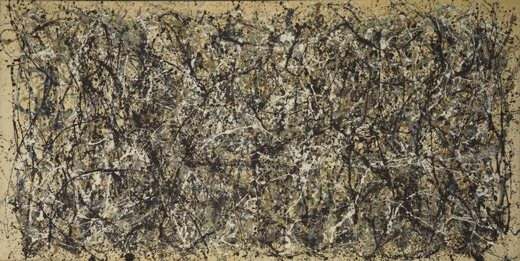
Tyler's exercise interesting and--in this case--harmless, but it's also artificial almost to the point of irrelevance. Set aside the discussion of just how much "dominance" MoMA's installation has or should be granted in the polyvalent art world of 2007 [I'm a longtime MoMA supporter and fundraiser for whom the Museum functioned as an ersatz graduate school of modernism, which may be why I feel so strongly that the art world should have outgrown the self-inflicted notion of centralized canonizing authorities by now. And except for when we play these kinds of curatorial parlor games, I think most people have.]
The sequence of galleries on MoMA's fifth floor forms the basis of MAN's "dominant installation" theory:
MoMA's installation, which is in part an accident of architecture and in part not (someone put all those Pollocks together and banished everyone else), encourages us to see Pollock as the titan, the artist who, along with Picasso and Matisse gets a MoMA gallery to himself. The not-so-subtle suggestion is that everything else in American hero painting stems from Pollock, that it all comes after him, that no one else is worthy of sharing his space. As proof, at MoMA those other artists all are after Pollock, not with him.
OK, but that's not how it happened...
Tyler has been spending the last few days expanding on that by showing what other artists' momentous works from 1950 which were created alongside [i.e., concurrent with] Pollock's, but which MoMA baldly puts in other rooms.
Rather than simply point out what seems to me an inherent flaw in Tyler's premise--unless you're talking about Jerry Saltz's curatorial fantasy of lining up all the works in the collection by the date they left the studio, the march through architecture does not only ever equal the march of time; in fact, since its conception before the MoMA2000 era, the Taniguchi building & installation has been intended to alleviate, if not obviate, the outdated, pedantic, this-begets-that, historicist puzzle-solving--I'll counter with a lost installation example from the, uh, Bad Old MoMA that I think unproves Tyler's point today about Barnett Newman's massive painting, Vir Heroicus Sublimis. It also happens to be one of the most sublime juxtapositions of art I've ever seen.
In the old MoMA's 4th floor galleries, Pollock did have a gallery to himself, but it wasn't the apotheosis of anything. The Pollock room was off to the right, with One: Number 31, 1950 on the main wall, while History marched on to the left; to the architectural determinists in the audience, Pollock was a dead end.
Only, of course, it wasn't. When you turned around and looked through a couple of enfilade doorways, there was Newman's Vir Heroicus Sublimis facing you--and the Pollock to your back. I forget what was in those galleries--late Matisse, maybe? who could care?--because these turning back and forth between these two giant paintings made the same year was too engrossing. Newman wasn't taking the "next-steps of American high-abex," he was making his own powerful arguments longside/against/in response to [sic] Pollock's painterly actionism.
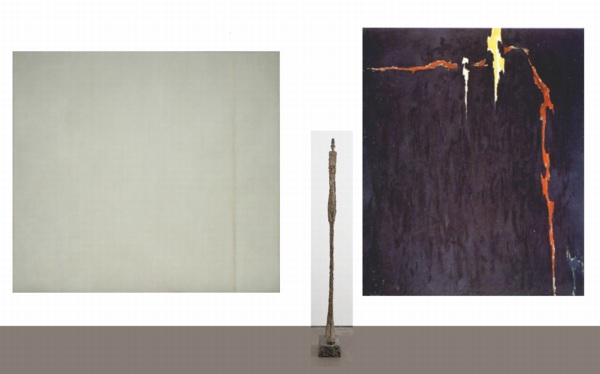
When you got into the room with the Newman, though, things really heated up. On the right/west wall [recreated above in Photoshop] hung another 1950 Newman, The Voice [above, l], and next to it was a Clyfford Still. If the timeline were the arbiter, it'd be 1951-T No. 3, a work whose reused abstract composition Still dubbed a "replica." [Let's see Pollock try that.] But I'm almost certain it was the much earlier--d'oh, and thus asynchronous--1944-N No. 2 [above, r].
The greatest touch, though, was the most seemingly controversial: the insertion of a European sculpture, Giacometti's Standing Woman, from 1948, which functioned visually as, of all things, a humanoid zip. I've never looked in the literature, but I can't imagine how this time- and continent-and style-hopping installation could be considered anything but heresy to those who insist that someone's insisting on brightline, AbEx and The American Way art history. And yet, there it was, right there in the heart of MoMA. Did anyone complain? Or did it just look too awesome? Or was there always more to the Newman et al. story, like what artists themselves thought, even at MoMA? from Vir Heroicus Sublimus' page at MoMa.org:
Newman admired Alberto Giacometti's bone-thin sculptures of the human figure, and his stripes, or "zips," as he called them, may be seen as symbolizing figures against a void.
Taniguchi's MoMA makes some attempt to break up the classical, enfilade march of galleries, but it's obviously not perfect. The classical vista and the faceoff have been replaced by the turn and the oblique glimpse as the museum's spatial and viewing modes. When they hung the new galleries, MoMA's curators programmed in these pans and the distant glimpses of resonant works afforded by all the new, non-dogmatic doorways.
But even if you don't buy into this attempt at mixing it up, can anyone realistically expect that MoMA would destroy itself as a historically continuous institution "merely" to accommodate the fifth renovation of its space? Should the ghost of a building known as the Dorset Hotel hold sway over Art History, its circumstances defining the shapes and flow of the galleries much as the one-by-one acquisition of the townhouses that once occupied the original 53rd Street site did? MoMA's linearity, both spatial and intellectual, is a historical phenomenon as driven as much by these palimpsest floorplans as by Barr and Rubin's schematic diagrams.
And this received wisdom is actually influenced as much by the trustees and collectors and tastes of the era, too; remember, despite several attempts by dealer/trustee Sidney Janis to place it there, Barr and MoMA refused Pollock's Autumn Rhythm, which finally ended up at the Met. And it wasn't until 1967, well into the Rubin era, that they could even manage to acquire One, No. 31, 1950 at all. If people actually knew more about the messy, cantankerous, and wrangling processes of how that "dominant installation" came to be, they may not be so inclined to let it dominate them.
And if they're going to be strict architectural literalists in their interpretation of a the symbolism of a museum installation, they might as well look back to the Old Testament MoMA as well. And they might as well note that Newman's painting currently hangs in the same spot as Picasso's Les Demoiselles d'Avignon on the floor below. Maybe Newman is Moses and Pollock is just Aaron. Or Pollock's John the Baptist, and Newman's--well, I'm sure Newman would've been pleased with the spot he got.
